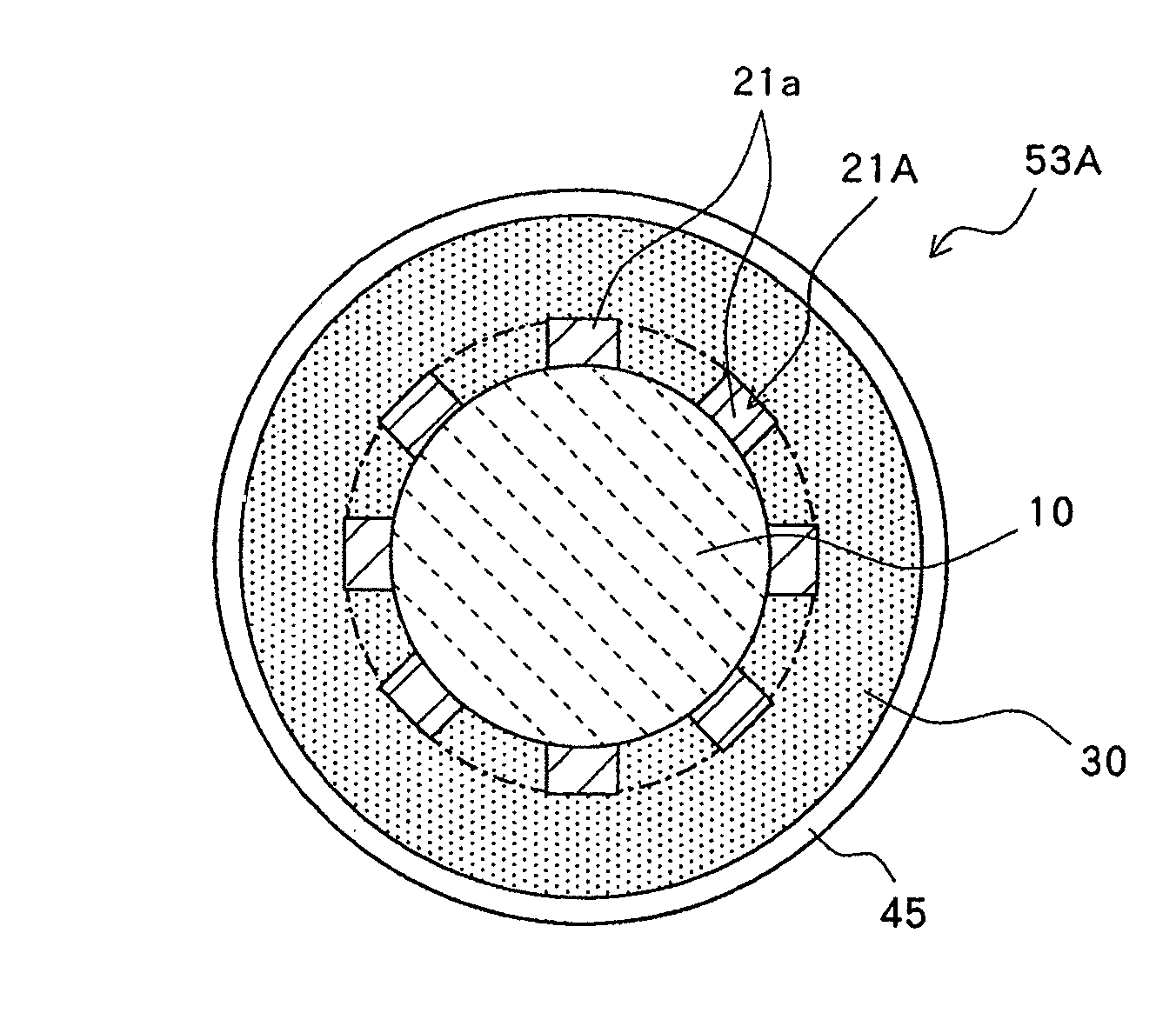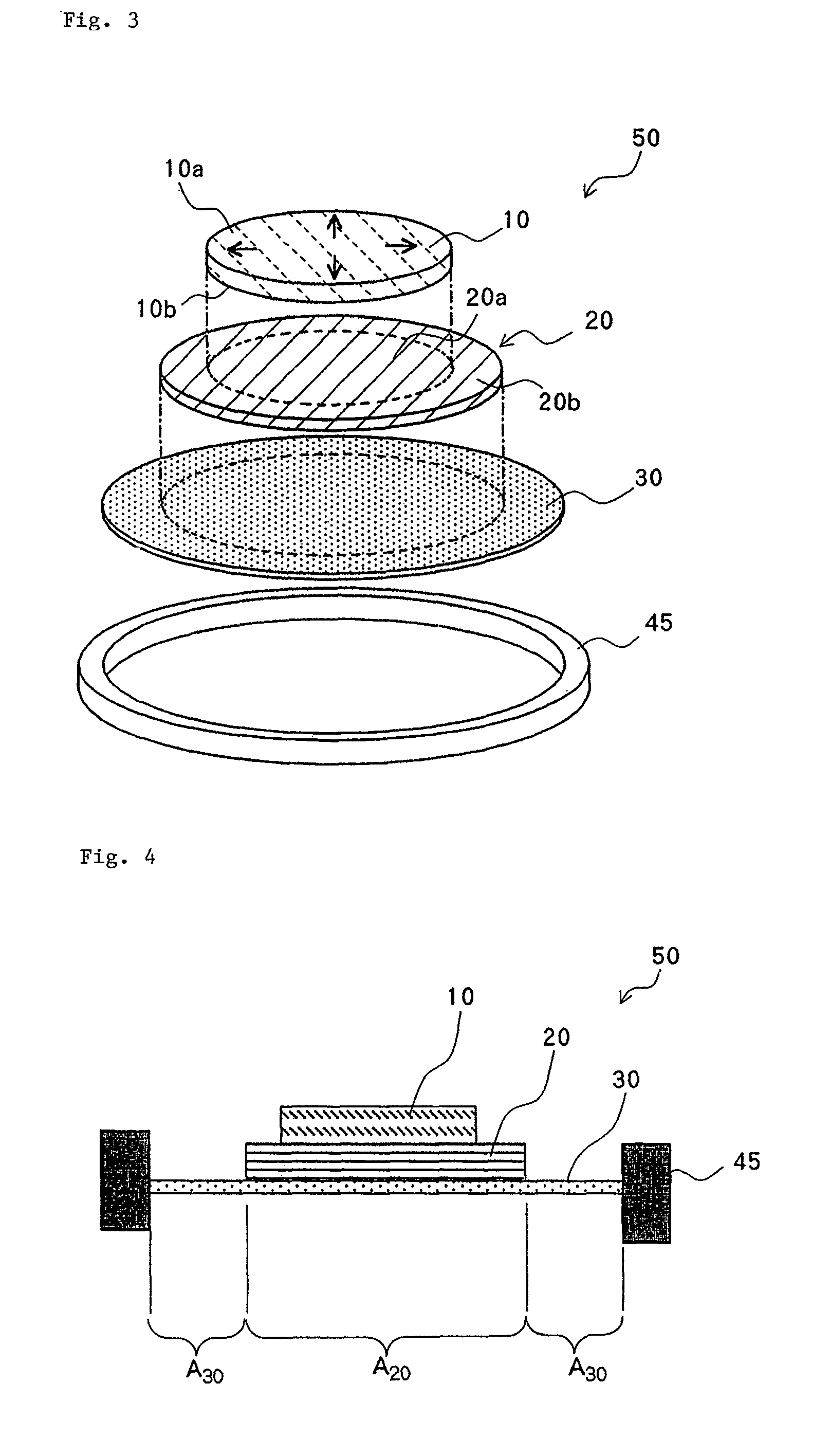Piezo-electric actuator and electronic device
a technology of electric actuators and actuators, applied in the direction of generators/motors, mechanical vibration separation, instruments, etc., can solve the problems of not being considered for music reproduction, and achieve the effects of less rigidity, increased vibration amplitude, and increased resistance to deformation
- Summary
- Abstract
- Description
- Claims
- Application Information
AI Technical Summary
Benefits of technology
Problems solved by technology
Method used
Image
Examples
first embodiment
[0061]FIG. 3 is an exploded perspective view of a piezo-electric actuator of this embodiment, and FIG. 4 is a vertical sectional view of the piezo-electric actuator of FIG. 3.
[0062]As shown in FIGS. 3 and 4, piezo-electric actuator 50 of this embodiment comprises piezo-electric element 10 which serves as a driving source of vibration; seat 20 for supporting piezo-electric element 10; and vibration film 30 for supporting seat 20 in a configuration in which they are laminated in order. Piezo-electric element 10, seat 20, and vibration film 30 all have circularly shaped contours, and these three members are (concentrically) arranged such that they are centered at the same point. The outer periphery of vibration film 30 is connected to and supported by supporting member 45 which is formed in a circular frame shape.
[0063]More specifically, piezo-electric element 10 comprises a piezo-electric plate (piezo-electric ceramics) having two main surfaces 10a, 10b which oppose in parallel with e...
second embodiment
[0088]In the piezo-electric actuator of the present invention, a flection amount δ (m) of vibration film intervening section A between the outer periphery of the seat and the inner periphery of the supporting member can be calculated in the following manner. In this regard, vibration film intervening section A between the outer periphery of the seat and the inner periphery of the supporting member, i.e., vibration film intervening section A (30a) is an intervening site comprised of the vibration film positioned between outer periphery 20c of seat 20 and inter periphery 45a of supporting member 45, as shown in FIG. 7, and flection amount δ (m) of this vibration film intervening section A is calculated from the following calculation equation (1).
[0089]A description will be given of a method of calculating flection amount δ of vibration film intervening section A in the present invention. Calculation equation (1) described below is an equation applied to vibration film intervening sect...
third embodiment
[0102]The piezo-electric actuator of the present invention is not limited to those shown in the foregoing embodiments, but may have a configuration as shown in FIGS. 11A, 11B. FIG. 11A is an exploded perspective view showing the configuration of a piezo-electric actuator of a second embodiment, and FIG. 11B is a vertical sectional view of the piezo-electric actuator.
[0103]Piezo-electric actuator 51 of FIGS. 11A and 11B employs vibration film 31 which is formed with opening 31a at the center thereof. The rest of the configuration is similar to the first embodiment. Opening 31a is circular, and is formed to be concentric with piezo-electric element 10 and seat 20. Since opening 31a is formed, seat 20 is supported only around the outer periphery of its back surface (bottom surface as shown in the figure) by vibration film 31. Stated another way, the back surface of seat 20 has an area corresponding to opening 31a in an exposed state.
[0104]Even piezo-electric actuator 51 of this embodim...
PUM
 Login to View More
Login to View More Abstract
Description
Claims
Application Information
 Login to View More
Login to View More - R&D
- Intellectual Property
- Life Sciences
- Materials
- Tech Scout
- Unparalleled Data Quality
- Higher Quality Content
- 60% Fewer Hallucinations
Browse by: Latest US Patents, China's latest patents, Technical Efficacy Thesaurus, Application Domain, Technology Topic, Popular Technical Reports.
© 2025 PatSnap. All rights reserved.Legal|Privacy policy|Modern Slavery Act Transparency Statement|Sitemap|About US| Contact US: help@patsnap.com



